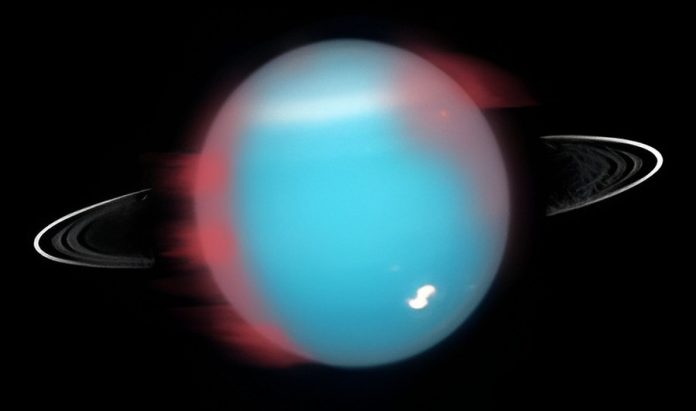
Scientists from the University of Leicester have made a groundbreaking discovery on Uranus.
For the first time ever, they’ve detected a special kind of light show called an infrared aurora.
This discovery could help answer big questions about magnetic fields on planets, and might even give us hints about which faraway planets could support life.
Auroras, like our Northern and Southern Lights here on Earth, are breathtaking displays in the sky. They’re caused when charged particles from space crash into a planet’s atmosphere.
This happens along the lines of the planet’s magnetic field.
While our own auroras are visible to the naked eye, the ones on Uranus can’t be seen in the usual way because they shine in infrared, a type of light that is beyond what our eyes can pick up.
Why is the aurora on Uranus so special? Well, Uranus and its fellow “ice giant” Neptune are the oddballs of our solar system.
The reason is that their magnetic fields don’t line up with the direction they spin. No one really knows why, but this new aurora discovery might provide some clues.
To detect this infrared aurora, the research team looked at light coming from Uranus through a big telescope called the Keck II. They studied specific “colors” of this light to learn more about what’s happening in the planet’s atmosphere.
A particle called H3+ played a big role in their research. By looking at the light given off by this particle, the scientists could tell things like temperature and density in the atmosphere. It was a bit like using the light as a thermometer to see what’s going on inside the planet.
During their observations, they noticed that there were a lot of H3+ particles in Uranus’s atmosphere, but the temperature didn’t change much. This hinted that there was an infrared aurora happening.
This discovery helps scientists better understand the strange magnetic behaviors of distant planets. And, excitingly, it could also help us figure out which other planets out there might be good places for life.
Emma Thomas, the lead researcher and a Ph.D. student, explained that big planets like Uranus are much hotter than they should be if they only got heat from the sun. One idea is that the auroras, full of energy, might be what’s warming them up.
Many of the planets we’ve found outside our solar system are a bit like Neptune and Uranus in size. So, Emma suggests that if we understand the auroras and magnetic fields on Uranus, we can guess what’s happening on those distant planets too. This might even tell us if they’re good places for life to thrive.
Emma also pointed out that studying Uranus can teach us about our own planet. Sometimes, Earth’s north and south poles swap places in an event called a “geomagnetic reversal”.
We don’t know much about this rare event, but it happens daily on Uranus. So, by studying Uranus’s aurora, we might learn what to expect if Earth’s poles ever decide to switch.
In conclusion, this new discovery is more than just a fancy light show on a distant planet. It’s a piece of the puzzle that helps scientists understand our solar system, distant planets, and even our own Earth a bit better.
Follow us on Twitter for more articles about this topic.



